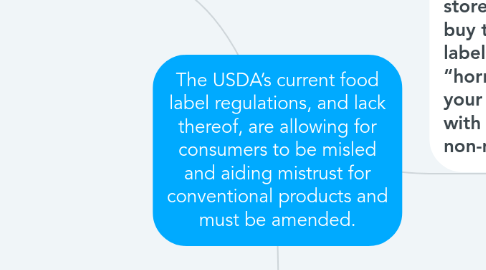The USDA’s current food label regulations, and lack thereof, are allowing for consumers to be misled and aiding mistrust for conventional products and must be amended.
by Anne-Hunter Stone

1. Call the USDA Food Safety and Inspection Service’s Chief of Staff, Karen Hunter, at (202) 720-6618 today and express your concern over the need for stricter regulations on the animal product labels that are misleading consumers.
1.1. A 2017 Consumer Reports survey showed than 73% of consumers are misled by the term “natural” on food labels (Daguin, 2016).
1.2. The “Grass-fed”, “humanely raised”, “local” and “small family farm” labels are not concretely defined by the USDA (Daguin, 2016).
1.3. All broiler chickens and turkeys in the US are not kept in cages, but the “cage free” label is still allowed on packaging (Danguin, 2016).
1.4. The most significant consumer meat safety concern found in a 2010 study was that pertaining to hormone use, and more specifically, hormone residue being in the meat (Radam & Yacob, 2010).
1.5. Consumers are increasingly showing a concerns over meat quality and safety, but difficulty in identifying what that actually means (Radam & Yacob, 2010).
1.6. A 2015 Consumer Report survey found more than half of participants looked for the word “natural” on food labels (Lawler, 2017).
2. Make a donation in the name of stricter food labeling regulations today to Farm Aid, one of the most influential organizations in advocating for fair farm and consumer policies, at https://give.farmaid.org/give/241271/?utm_source=web&utm_medium=web&u tm_campaign=Main%20Donate%20Link#!/donation/checkout.
2.1. Average annual growth rates for certified organic products are ~17.85% opposed to ~2-3% for conventional (Bezwada & Pauwels, 2013).
2.2. Small farmers who noted the costliness of disease, insects, and fertility as the cost barrier to getting certified organic, but still used organic practices, had 17.05% less production and were unable to sell their products at organic cost (Alexander & Marshall, 2014).
2.3. A Food Policy study found that larger farms on average have 8.85%-17.81% more production after attaining organic certification, with the time and resources required for certification not being noted as an obstacle for them (Alexander & Marshall, 2014).
2.4. Producers who report their most important market being direct, which includes either farmer’s markets, on-farm selling, and CSAs, report a 7.44% loss after undergoing certification (Alexander & Marshall, 2014).
2.5. Almost all of the farmers that utilize local markets and have a face-to-face relationship with customers in the 2014 Food Policy Study reported using organic practices but being confused about how to go about the process. (Alexander & Marshall, 2014).
2.6. A 2010 study published in the British Food Journal found that marketing, packaging, and pricing of organic foods also led to a perception that it meant “home-grown” food (Harper & Makatouni, 2002).
3. Next time you’re in the grocery store, save your money and don’t buy the animal products with labels like “from happy hens” or “hormone-free” and instead show your support for the products with only regulated, non-misleading labels.
3.1. Retail margins are 25.18% higher on average for organic products (Bezwada & Pauwels, 2013).
3.2. Almost always, products with a “natural” or “hormone-free” label are more expensive than those without (Calderone, 2016).
3.3. It is not just smaller companies abusing the “no added hormones or steroids” labels, as industry leader Tyson even takes part (Calderone, 2016).
3.4. A 2002 study published in the British Food Journal Consumers, found majority of the consumers surveyed, both self-proclaimed organic buyers and those who are not, showed a perception of organic animal products, as a result of food label marketing, that the animals were free- range.
3.5. In a 2010 study, a significant part of the respondents who claimed to buy meat with various extra labels failed to recall what those labels actually were (Radam & Yacob, 2010).
3.6. A substantial amount of consumers admitted to social approval driving their choice to buy products with the certified organic label (Bezwada & Pauwels, 2013).
3.7. The consumers surveyed in a 2016 study only showed willingness to pay $1.49 per pound with a sustainable label, the same amount they were willing to pay for a local label, and seemed to get the two confused (Shupp & Tonsor, 2016).
3.8. Consumers often start with switching to organic in produce, meat, and dairy and see those as the most beneficial areas to do so (Bezwada & Pauwels, 2013).
3.9. Research has shown consumers identify buying certified organic products as part of achieving certain life values (Bezwada & Pauwels, 2013).


